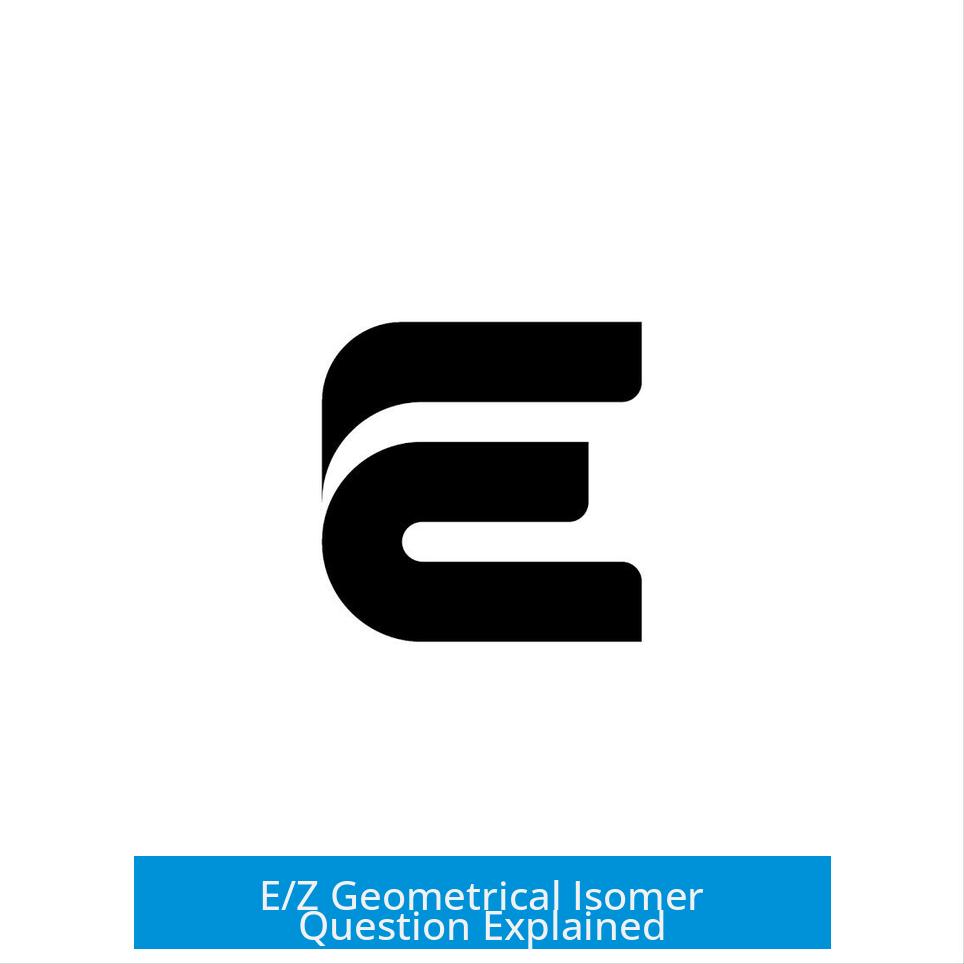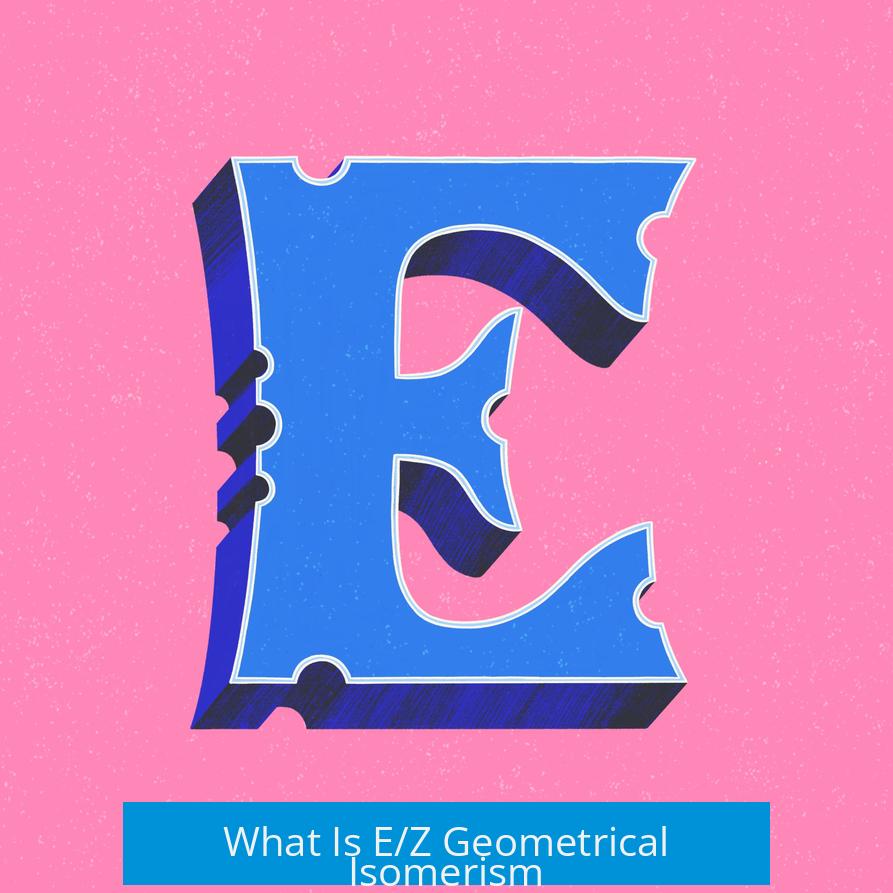E/Z Geometrical Isomer Question Explained

The E/Z notation categorizes geometric isomers based on the relative positions of the highest priority substituents around a carbon-carbon double bond. Unlike the simpler cis/trans system, E/Z is the official IUPAC method and applies universally to alkenes with any substituents.
What Is E/Z Geometrical Isomerism?

Geometric isomers occur in molecules with restricted rotation around double bonds. These isomers share the same structural formula but differ in spatial arrangement.
The E/Z system classifies isomers by comparing the position of the substituents with the highest priorities on each carbon of the double bond:

- Z (zusammen): The highest priority groups are on the same side of the double bond.
- E (entgegen): The highest priority groups are on opposite sides.
Determining Priorities Using Cahn–Ingold–Prelog Rules
Assigning E or Z requires applying the Cahn–Ingold–Prelog priority rules. These rules rank substituents based on atomic number:

- Look at the atoms directly attached to the double-bonded carbons.
- The substituent with the higher atomic number gets higher priority.
- If there is a tie, compare atoms along the chain until a difference is found.
Why Not Use Cis/Trans Nomenclature?
Cis/trans designations only work well when each carbon has one substituent of the same type and one different. It can become ambiguous if substituents vary widely or more than two different groups are attached.
The E/Z system resolves this by basing classification strictly on priority rather than substituent identity alone.
How to Identify E or Z in Practice
Consider an alkene with four groups attached:
| Step | Action |
|---|---|
| 1 | Assign priority to substituents on each carbon using CIP rules. |
| 2 | Determine whether the highest priority groups on each carbon are on the same or opposite sides. |
| 3 | Label as Z if same side, E if opposite. |
Instead of guessing “cis” or “trans,” apply these steps systematically for any substituted alkene.
Additional Notes on Structure
Double bond carbons are trigonal planar; rotation is restricted, which allows these isomers to exist separately. This geometric rigidity is key for categorizing E/Z forms.
- Isomers with identical substituents on both carbons can be easily recognized.
- Complicated substituents require careful priority assignment.
Key Takeaways
- E/Z notation depends on the relative positions of the highest priority groups across a double bond.
- Cahn–Ingold–Prelog rules assign priority based on atomic numbers.
- Cis/trans naming can be ambiguous; E/Z is universally accurate.
- Geometric isomers differ only in spatial arrangement, not connectivity.
- Double bonds restrict rotation, enabling the existence of distinct E and Z forms.
Mastering the E/Z Geometrical Isomer Question: A Practical Guide
Wondering how to nail E/Z geometrical isomer questions? It may seem tricky at first, but once you grasp the core idea—identifying whether substituents on a double bond are on the same side or opposite sides—you’re halfway there. Hint: This is not about cis or trans, despite popular confusion. Instead, it’s about the IUPAC-approved E/Z notation, which offers a foolproof system for naming all alkene isomers.
Let’s unpack this topic with clarity, some mild humor, and practical tips to stop you from scrambling over the same old confusion.
Why Not Just Stick to Cis/Trans? The Case for E/Z
Everyone’s heard of cis and trans when describing double bonds. But here’s the kicker: cis/trans only works neatly when substituents are obvious and symmetrical, like two hydrogens on a double bond or simple groups. The moment you have more complex or different groups, cis and trans get ambiguous.
Enter the E/Z system — the official, standardized IUPAC method. It reliably covers all cases by focusing on priority, rather than just left or right, same or opposite sides.
Think of cis/trans as the “quick slang” version. It’s like calling someone “Bob.” E/Z is the official first, middle, and last name—it leaves zero room for confusion!
Getting Clear on What E and Z Actually Mean
E stands for entgegen, German for “opposite.” Z stands for zusammen, meaning “together” or “on the same side.”
So, for a double bond, if the highest priority substituents on each carbon are on opposite sides, we’ve got the E isomer. If they’re on the same side, it’s the Z isomer.
Sounds simple? Sure, but here’s the catch: you must correctly assign priority before deciding if it’s E or Z. Misread the priority, and you end up mixing them like socks after laundry day.
The Priority Rules: Cahn–Ingold–Prelog to the Rescue
Before labeling anything as E or Z, always apply the Cahn–Ingold–Prelog (CIP) priority rules. This method ranks substituents based on atomic number and connectivity.
- Look at the atoms directly attached to each double-bonded carbon.
- The atom with the higher atomic number takes priority.
- If there’s a tie, move outward along the chain until you find a difference.
For example, comparing Br (atomic number 35) and H (atomic number 1) on a carbon, Br wins in priority hands down. On the other carbon, Cl (17) beats CH3 (with C connected to H’s), so Cl gets the higher priority.
Assign priorities carefully on both carbons. The highest priority groups on each carbon tell you how to classify the isomer.
Practice Makes Perfect: Examining Molecular Examples
Let’s take a few hypothetical examples—think of them as little molecular puzzles waiting to be solved.
- Example 1: A double bond with substituents H and Br on one carbon, and H and Cl on the other.
- Example 2: A more complex double bond with H and Cl on one carbon, Br and CH3 on the other.
- Example 3: Double-bonded carbons each bonded to CH2OH and CH3CH2 on one, and CH3 and CH2Cl on the other.
For each, assign priority groups on both carbons using CIP rules. Then compare whether the highest priority groups are on the same side or opposite. Voilà! You can now determine if it’s an E or a Z isomer.
For instance, in Example 1, Br outranks H, and Cl outranks H. If Br and Cl sit across from each other, it’s E. If Br and Cl sit together, it’s Z.
Don’t Forget: Geometry Shapes the Story
One more thing to keep in mind: the double bond is planar and rigid. The carbons involved in the double bond are trigonal planar—not tetrahedral—meaning they lie flat, restricting rotation about the bond. This rigidity is the reason why you get distinct geometric isomers in the first place.
This also explains why molecules with chiral centers aren’t involved here—this system focuses purely on geometric arrangements around double bonds.
A Quick Pitfall to Avoid: Mixing Up E and Z
Before you rush to answer any question: take a deep breath and clarify the concept inside your head. Which one is “same side” and which one “opposite side”? Flip it around if needed—better than confidently getting every single answer wrong.
A good tip: draw out the molecule if the question is presented as a line structure or formula. Seeing substituents in their relative positions helps you visually decide E or Z rather than guessing.
Here’s a Simple Strategy to Help You Always Know Your E from Your Z
- Identify the double-bonded carbons.
- Assign priorities to substituents on each carbon (highest atomic number wins).
- Look at the high-priority substituents: same side = Z, opposite side = E.
- Double-check! If confused, sketch the molecule or visualize rotating around bonds (not the double bond’s—it can’t rotate).
The Big Takeaway
Ultimately, the E/Z system neatly replaces the old cis/trans jingle with a crystal-clear, IUPAC-approved way to describe double bond isomers. It owes its clarity to how it lifts confusion: precise priority rules and careful geometric assessment.
So, next time you face an E/Z geometrical isomer question, remember this is less about memorizing ‘which side is what’ and more about logical priority assignments and spatial awareness.
Try it out on the molecular diagrams you encounter or in your study book. Challenge yourself to draw and assign E/Z to every new alkene you see. After a couple of tries, you might even stop wondering why this ever seemed complicated.
Who knew double bonds could be so orderly, yet glam enough to earn specific names? And now, so do you.
“Understanding E/Z isomers doesn’t need to feel like decoding ancient runes. With the right clues, it’s just science, geometry, and a pinch of logic!”
What determines if an alkene is labeled E or Z?
The E/Z notation depends on the positions of the highest priority groups attached to each carbon of the double bond. If these groups are on the same side, it’s Z. If opposite, it’s E.
How do Cahn–Ingold–Prelog rules help assign E/Z isomers?
These rules give priority to groups attached to the double-bonded carbons based on atomic number. Correct priority assignment is key to naming E or Z isomers accurately.
Why isn’t cis/trans terminology always correct for alkenes?
Cis/trans can be unclear when groups differ on each carbon. The E/Z system avoids this ambiguity and works for all alkenes with geometric isomerism.
Can a molecule with trigonal planar carbons be chiral?
No. Chirality requires a tetrahedral center. Alkenes with trigonal planar centers can have geometric isomers but are not chiral.
How can one identify the E or Z form from a molecular diagram?
Compare the priority groups on each double-bonded carbon using CIP rules. If high priority groups line up on the same side, it’s Z; if opposite sides, it’s E.





Leave a Comment